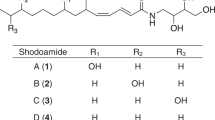Abstract
Based on NH2-(AEEA)5-amphotericin B (DMR005; AEEA is 8-amino-3,6-dioxaoctanoic acid), a series of novel esterified and acylated derivatives of DMR005 were synthesized. These derivatives were evaluated for their antifungal activities using the broth dilution method, for their hemolytic toxicity with sterile defibrinated sheep blood, and for their self-association through UV–visible spectroscopy. The preliminary screening tests indicated that NH2-(AEEA)5-amphotericin B methyl ester (DMR031) was an ideal compound. The results of minimum inhibitory concentration and time-kill assays showed that antifungal activities of DMR031 (4 μg ml−1) against Candida albicans ATCC10231 and ATCC90028 were reduced by four times compared to these of amphotericin B (AmB) (1 μg ml−1). DMR031 (142 ± 1 mg ml−1) significantly improved the water solubility of AmB as DMR005 did. Preliminary safety assessments of DMR031 were carried out via cell toxicity assay of HEK293T in vitro, which turned out to be much better than AmB. AmB had good efficacy in vivo at a dose of 1 mg ml−1. However, DMR031 still had no efficacy in vivo even at a dose of 16 mg ml−1, merely prolonged the survival time of mice.
This is a preview of subscription content, access via your institution
Access options
Subscribe to this journal
Receive 12 print issues and online access
$259.00 per year
only $21.58 per issue
Buy this article
- Purchase on Springer Link
- Instant access to full article PDF
Prices may be subject to local taxes which are calculated during checkout







Similar content being viewed by others
References
Oura M, Sternberg TH, Wright ET. A new antifungal antibiotic, amphotericin B. Antibiot Annu. 1956;3:566–73.
Donovick R, Gold W, Pagano JF, Stout HA. Amphotericins A and B, antifungal antibiotics produced by a streptomycete. I. In vitro studies. Antibiot Annu. 1956;3:579–86.
Saravolatz LD, Ostrosky-Zeichner L, Marr KA, Rex JH, Cohen SH. Amphotericin B: time for a new “gold standard”. Clin Infect Dis. 2003;37:415–25.
Bartner E, Zinnes H, Moe RA, Kulesza JS. Studies on a new solubilized preparation of amphotericin B. Antibiot Annu. 1957;5:53–8.
Deray G. Amphotericin B nephrotoxicity. J Antimicrob Chemother. 2002;9:37–41.
Fanos V, Cataldi L. Amphotericin B-induced nephrotoxicity: a review. J Chemother. 2000;12:463–70.
Laniado-Laborín R, Cabrales-Vargas MN. Amphotericin B: side effects and toxicity. Rev Iberoam Micol. 2009;26:223–7.
Dupont B. Overview of the lipid formulations of amphotericin B. J Antimicrob Chemother. 2002;49:31–6.
Hartsel SC, Baas B, Bauer E, Foree LT, Kindt K, Preis H, et al. Heat-induced super-aggregation of amphotericin B modifies its interaction with serum proteins and lipoproteins and stimulation of TNF-alpha. J Pharm Sci. 2001;90:124–33.
Bonner DP, Mechlinski W, Schaffner CP. Polyene macrolide derivatives. 3. Biological properties of polyene macrolide ester salts. J Antibiot. 1972;25:261.
Grzybowska J, Sowiński P, Gumieniak J, Zieniawa T, Borowski E. N-methyl-N-D-fructopyranosylamphotericin B methyl ester, new amphotericin B derivative of low toxicity. J Antibioti. 2006;50:709–11.
Hąc-Wydro K, Dynarowicz-Łątka P, Grzybowska J, Borowski E. N-(1-piperidinepropionyl) amphotericin B methyl ester (PAME)-a new derivative of the antifungal antibiotic amphotericin B: searching for the mechanism of its reduced toxicity. J Colloid Interface Sci. 2005;287:476–84.
And VP, Carreira EM. Significant improvement of antifungal activity of polyene macrolides by bisalkylation of the mycosamine. Org Lett. 2006;8:1807–9.
Zhang JH, Ma J, Dong YZ, Zhao WJ, Feng J. Synthesis and characterization of NH2-(AEEA)n-amphotericin B derivatives. J Antibiot. 2019;72:210–7.
Espinel-Ingroff A, Fothergill A, Ghannoum M, Manavathu E, Ostrosky-Zeichner L, Pfaller MA, et al. Quality control and reference guidelines for CLSI broth microdilution susceptibility method (M 38-A document) for amphotericin B, itraconazole, posaconazole, and voriconazole. J Clin Microbiol. 2005;43:5243.
Klepser ME, Ernst EJ, Lewis RE, Ernst ME, Pfaller MA. Influence of test conditions on antifungal time-kill curve results: proposal for standardized methods. Antimicrob Agents Chemother. 1998;42:1207–12.
Bulmus V, Woodward M, Lin L, Murthy N, Stayton P, Hoffman A. A new pH-responsive and glutathione-reactive, endosomal membrane-disruptive polymeric carrier for intracellular delivery of biomolecular drugs. J Control Release. 2003;93:105–20.
Higuchi TA, Connors KA. Phase-solubility techniques. In: Advances in analytical chemistry and instrumentation. Manhattan, USA: Jonh Wiley & Sons, INC; 1965.
Jouyban A. Handbook of solubility data for pharmaceuticals. Vol. 3. Florida, USA: CRC Press; 2010. p. 198–202.
Slisz M, Cybulska B, Mazerski J, Grzybowska J, Borowski E. Studies of the effects of antifungal cationic derivatives of amphotericin B on human erythrocytes. J Antibiot. 2004;57:669–78.
Itai B, Nir O, Vladimir D, Alex MS. Amphotericin B derivatives. USA, US20170319705A1. 2017.
Barwicz J, Christian S, Gruda I. Effects of the aggregation state of amphotericin B on its toxicity to mice. Antimicrob Agents Chemother. 1992;36:2310–5.
Acknowledgements
This study was supported by the National Key R&D Program of China (2017YFD0501404).
Author information
Authors and Affiliations
Corresponding author
Ethics declarations
Conflict of interest
The authors declare that they have no conflict of interest.
Additional information
Publisher’s note Springer Nature remains neutral with regard to jurisdictional claims in published maps and institutional affiliations.
Supplementary information
41429_2020_365_MOESM1_ESM.docx
The synthetic methods of Fmoc-DMR005 and the compound properties of esterified and acylated derivatives of DMR005 in detail
Rights and permissions
About this article
Cite this article
Zhang, J., Dong, Y., Xu, H. et al. Synthesis and biological evaluation of esterified and acylated derivatives of NH2-(AEEA)5-amphotericin B. J Antibiot 74, 133–142 (2021). https://doi.org/10.1038/s41429-020-00365-3
Received:
Revised:
Accepted:
Published:
Issue Date:
DOI: https://doi.org/10.1038/s41429-020-00365-3



